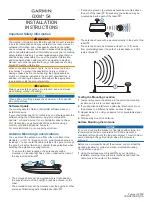
53
2.
Install all hardware and tighten to 8 Foot Pounds.
3.
Repeat procedure for all screws on all flange connections.
4.
After all electronic tests have been performed, wipe clean with isopropanol (not supplied),
allow to dry and apply sealer, using brush (item 19) supplied, to entire periphery of waveguide
flanges. It shall in all cases bridge completely interfaces between flange faces.
a.
Mount waveguide support hardware between feed support channels as shown in sections A-A and
B-B (Figure 3-9), except do not assemble retainers (item 15) or their associated hardware.
b.
Assemble waveguide bend (item 1) as shown to the transducer of the lower feed using one of the
choke flange hardware kits (item 4).
c.
Attach the assembled upper waveguide run to the supports per sections A-A and B-B using spacers
(item 12), retainers (item 15), flat washers (item 9), split washers (item 10) and nuts (item 8) as
shown. Clamp the waveguide with the retainers (item 15) by running nuts down until clamping
pressure is firm but avoid over tightening to prevent damage to waveguide. All supports should be
positioned to minimize stress on the waveguide runs.
d.
Assemble the WR.284 Flexible Waveguide (item 16) from the end of this waveguide using a CPR
flange hardware kit (item 3).
e.
Assemble the lower waveguide bend (item 2) from the transducer of the upper feed as shown using
the one of the choke flange hardware kits (item 4).
f.
Assemble the WR.284 Flexible Waveguide (item 16) from the end of this waveguide using a CPR
flange hardware kit (item 3).
g.
Support the lower waveguide run in the same manner as the upper. Refer to Figure 3-9, sections A-A
and B-B.
h.
Waveguide runs should be centered, one over the other, and flanges secured (tightened) before final
securing of the supports (sections A-A and B-B).
i.
After waveguide runs have been secured, attach free flange ends of flexible waveguide to the mating
flanges of the Rotary Joint using M6 metric hardware and CPRG half gaskets from item 5.
CAUTION
DO NOT APPLY FORCE ON THE WAVEGUIDE FLANGE WHEN HANDLING OR
INSTALLING THE FLEXIBLE WAVEGUIDE. BENDING THE FLEXIBLE WAVEGUIDE
SHOULD BE DONE BY APPLYING FORCE ON THE BODY OF THE WAVEGUIDE AND
NOT ON THE FLANGES.
Содержание 174100
Страница 17: ...17 Figure 1 1 Typical Pattern Azimuth...
Страница 18: ...18 Figure 1 2 Typical Pattern Elevation...
Страница 19: ...19 Figure 1 3 Polarizer Schematic...
Страница 20: ...02 08 2016 SDR ASR11 052 TI 6310 59 20...
Страница 22: ...22 Figure 3 1 Complete Antenna Installation...
Страница 23: ...23 Figure 3 2 Shipping and Support Stand...
Страница 33: ...33 Figure 3 3 Base Interface Kit PSR Base Assembly...
Страница 35: ...35 Figure 3 4 Fixed Feeds Unit Installation...
Страница 42: ...42 Figure 3 5 Ladder Kit Installation...
Страница 45: ...45 Figure 3 6 PSR SSR Interface Mount Installation...
Страница 49: ...49 Figure 3 7 Antenna Lift Kit Installation...
Страница 54: ...54 Figure 3 8 Waveguide Installation...
Страница 55: ...55 Figure 3 9 Waveguide Hanger Installation...
Страница 61: ...61 Figure 3 11 SSR Coaxial Cable Installation and Tilt Scale Bracket Installation...
Страница 65: ...65 Figure 3 12 Antenna Feedhorn and Tilt Alignment Contour Cheek...
Страница 66: ...66 Figure 3 13 Antenna Azimuth Alignment...
Страница 67: ...67 Figure 3 14 Counterweight Installation...
Страница 81: ...02 08 2016 SDR ASR11 052 TI 6310 59 75 This Page Intentionally Left Blank...
Страница 82: ...76 Figure 4 1 Polarizer...
Страница 83: ...77 Figure 4 2 Polarizer Motor Replacement...
Страница 87: ...81 Figure 5 1 Test Antenna Kit...
Страница 89: ...83 Figure 6 1 Obstruction Lighting Kit...
















































